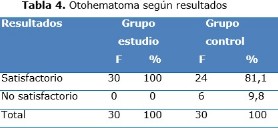Pear for maintained aspiration in the treatment of otohematoma
Abstract
Background: the otohematoma is a condition of traumatic origin of the auricular pavilion that is characterized by volume increase, deformity, pain and a tendency to unsightly sequels if the imposed therapy is not adequate and timely.
Objective: compare the results of the conventional technique with the proposed technique.
Methods: a quasi-experimental study was carried out in patients with otohematomas of the auricular pavilion for various reasons. The universe consisted of 60 patients who attended the Otolaryngology and Head and Neck Surgery clinic in Octavio de la Concepción and Pedraja hospital, from January 2012 to December 2014. 30 patients underwent the conventional therapeutic method and in another 30, a pear was used for maintained suction according to the proposed technique.
Results: the disease prevailed in ages within the second and third decade of life and most of the patients were males. Sport, work and military activities occupied the first places as causes of otohematomas. More than half of the patients from the study group cured in a fast way. Complications were infrequent in that group. The results of surgical treatment in the study group were satisfactory and superior to those from the control group.
Conclusions: the clinical, therapeutic, social and military results were higher for the patients to whom the proposed technique was applied.
DeCS: HEMATOMA; EAR AURICLE; SUCTION; ADULT; NON-RANDOMIZED CONTROLLED TRIALS AS TOPIC.
Downloads
References
1.Berendes J. Tratado de Otorrinolaringología. T.III Barcelona: Científico-Médica; 1969.
2.Boies LL. Diagnóstico y tratamiento de las enfermedades de la garganta, naríz y oídos. La Habana: Impresora Cubana; 1959.
3.Enríquez Merino J, Caballero Centeno AM, Pech Ortiz LG, García Castellón M. Técnica quirúrgica para el tratamiento de un otohematoma gigante. Dermatol Rev Mex. 2012;56(5):350-353.
4.Portman M. Otorrinolaringología. La Habana: Científico–Técnica; 1984.
5.Im GJ, Chae SW, Choi J, Kim YS, Kim WJ, Jung HH. Intralesional steroid injection for the management of otohematoma. Otolaryngol Head Neck Surg. 2008 Jul;139(1):115-9.
6.Boemo Dalcol RL, García Vaquero C, Saderra Estellers M, Navarrete ML, García Arumí A, Perelló Scherdel E. [A case of bilateral otohematoma]. An Otorrinolaringol Ibero Am. 2007;34(6):529-32.
7.Morozov IA. Treatment of Otohematoma. Vestn Otorinolaringol. 1973 Mar-Apr;35(2):102-3.
8.Thompson V. Clínica Otorrinolaringológica. La Habana: Instituto del Libro; 1983.
9.Conde JF. Clínica Otorrinolaringológica. Barcelona: Científico-Médica; 1972.
10.Paparella MM. Otorrinolaringología oído. 2 ed. La Habana: Científico–Técnica; 1983.
11.Botey RD. Otorrinolaringología. 3 ed. Barcelona: Salvat; 1918.
12.Enríquez Merino J, Alba Alcántara L de, Lemm Alba M del C. Otohematoma. Manejo quirúrgico de un caso. Rev Cent Dermatol Pascua. Sep-Dic 2003;12(3):34-45.
13.Savage R, Bevivino J, Mustafa E. Treatment of acute otohematoma with compression sutures.Ann Emerg Med. 1981 Dec;10(12):641-2.
14.Gusarov IuV. Use of active vacuum drainage in treatment of otohematoma. Zh Ushn Nos Gorl Bolezn. 1977 Sep-Oct;(5):98-9.
15.Caliceti G, Ceroni T. Otohematoma and serous perichondritis of the external ear. Otorinolaringol Ital. 1960 Dec;29:423-30.
16. Yoon CR, Min Hyun P. Use of Silastic Sheets With Mattress-Fashion Sutur es for the Treatment of Auricular Hematoma. Laryngoscope. 2015;125:730-732.
17.Summers A. Managing auricular haematoma to prevent cauliflower ear. Emerg Nurse. 2012 Sep;20(5):28-30.
18.Watson D, Panuganti B. Treating Scars in the Auricle Region. Facial Plast Surg Clin North Am. 2017 Feb;25(1):73-81.
19.Mohan V, Bhavani S, Subramanian SK, Maiti A. Calcified cauliflower ear in relapsing polychondritis. BMJ Case Rep. 2017 Apr 21;2017.
20.Watson D, Panuganti B. Treating Scars in the Auricle Region. Facial Plast Surg Clin North Am. 2017 Feb;25(1):73-81.
21.Mashiko T, Minabe T, Shiokawa I, Mineda K, Yoshimura K. Heterotopic ossification in cauliflower ear. J Plast Reconstr Aesthet Surg. 2014 Mar;67(3):e93-4.

Published
How to Cite
Issue
Section
License
Copyright: Camagüey Medical Archive Magazine, offers immediately after being indexed in the SciELO Project; Open access to the full text of the articles under the principle of making available and free the research to promote the exchange of global knowledge and contribute to a greater extension, publication, evaluation and extensive use of the articles that can be used without purpose As long as reference is made to the primary source.
Conflicts of interest: authors must declare in a mandatory manner the presence or not of conflicts of interest in relation to the investigation presented.
(Download Statement of potential conflicts of interest)
The Revista Archivo Médico de Camagüey is under a License Creative Commons Attribution-Noncommercial-No Derivative Works 4.0 International (CC BY 4.0).
This license allows others to distribute, to mix, to adjust and to build from its work, even for commercial purposes, as long as it is recognized the authorship of the original creation. This is the most helpful license offered. Recommended for maximum dissemination and use of licensed materials. The full license can be found at: https://creativecommons.org/licenses/












 22 julio 2025
22 julio 2025